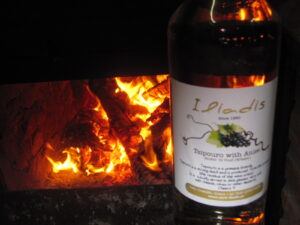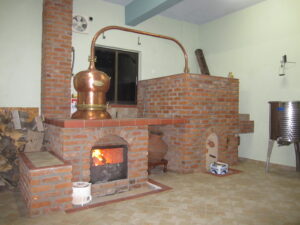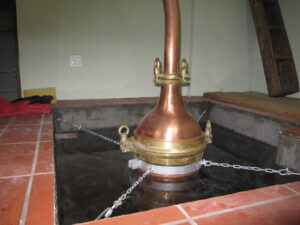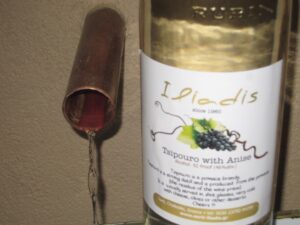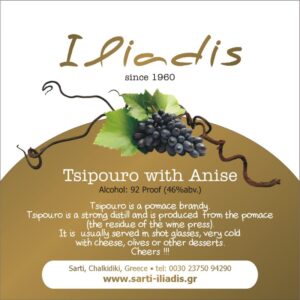
The family Iliadis works, since 1960, one of the two distilleries of tsipouro in Sarti.
Tsipouro is a strong distilled spirit containing approximately 45 percent alcohol by volume and is produced from the pomace (the residue of the wine press). According to the tradition, the first production of tsipouro was the work of some Greek Orthodox monks. This occurred during the 14th century on Mount Athos. In 2006, Greece filed a request to recognise tsipouro as a PDO (Protected designation of origin) product. An anise flavored Greek liquor that has the authentic taste of tradition because it is distilled with a selected aromatic plant of the Greek country-side: the Macedonian anise that for centuries has been sweetening and touching the hearts of Greeks.
In September, there’s the grape harvest. The grapes are carried from the vineyard in special tanks. They are put inside the tanks, where they’re being brewed (production of fungus that converts sugar to alcohol). So, the time comes for the production of traditional tsipouro, a very special occasion for our land, and a procedure that constitutes a ritual for us.
The month of October has always been very important to us, since they mark the continuation of a tradition, which survives to date. This is the time of the “cauldrons”, where the amvikes and the distillers, work day and night around the fire, following the very same procedure of many years. In the beginning there was the stemfyla. The Stemfyla or Tsipoura are the solid deposit of the grapes after removing the must, which will be used for the production of wine. The stemfyla or tsipoura are being put in buckets inside the amvika (cauldron), which is a boiler. Part of the brewing liquid is added to the stemfyla. Then, the cauldron is impenetrably shut with a bronze lid. Under the cauldron there’s a furnace, slowly burning, where the boiling starts. As soon as the stuff begins to boil, distillation starts. The steam go through a pipe to the top of the lid, and move to the bow, which is another pipe, that ends to a special socket at a larger pipe, which is inside a big tank of cold water, so that the steam can cool and be liquefied. We are now at the end of the first distillation. The degrees of the first distillation start from 27 and must reach 17, 15 or 14, by the end of the boiling. When they reach the relevant degrees, the first boiling, which lasts approximately one hour, ends. But the production of tsipouro has not finished. This first distillation is called “souma”, because it smells a lot and is extremely spicy. So it is being distilled for a second time, after we put souma in the cauldron with the anise (special spice), from where all stamfyla has been removed. This is called post-boiling, and is famous in our area, because this is when the good tsipouro is made. This second boiling refines the tsipouro and makes it more tasty. It is part of the hard work, but also great pleasure, since the whole procedure is connected to eating and drinking and having fun. So the hours over the cauldrons pass quickly, joyfully, with friends. Aniseed has been used to flavour some brands, creating a better quality drink, and more expensive. Slightly reminiscent of Ouzo, although a different drink entirely. Tsipouro is also known as Raki in parts of Greece. In Crete, a similar drink is made, but much stronger. This is called Tsikoudia.
The traditional values of Greek nature, the precious gifts of the Greek countryside, the genuineness and hospitality of all Greeks have always been reflected in this spirit drink stemming from grapes, Tsipouro. It has always been synonymous with Greek hospitality. It is the drink bound to relax us, the drink that urges us to join in and communicate with our friends, gather around a table and savor a wide assortment of traditional spicy mezedes, namely side dishes, constantly alternating flavors and aromas of the Greek mountains and deep-blue sea. Tsipouro indeed makes an excellent accompaniment to pungent-tasting meat and seafood cooked in a number of ways, matured cheese and processed meat products, not to mention pure earthy dishes such as pickles, grilled wild mushrooms, tomatoes in sea salt, olives on home-made rusks and oven-baked potatoes, as long as we satisfy our hunger in moderation and take small bites at a time, just enough to stimulate the taste buds.
You will drink this strong liquor in shot glasses, very cold with ice cube or water, often with feta cheese, olives or other appetisers and that is all you need. It will leave a trail of fire down your throat as you consume it.
Cheers!
To your health!
